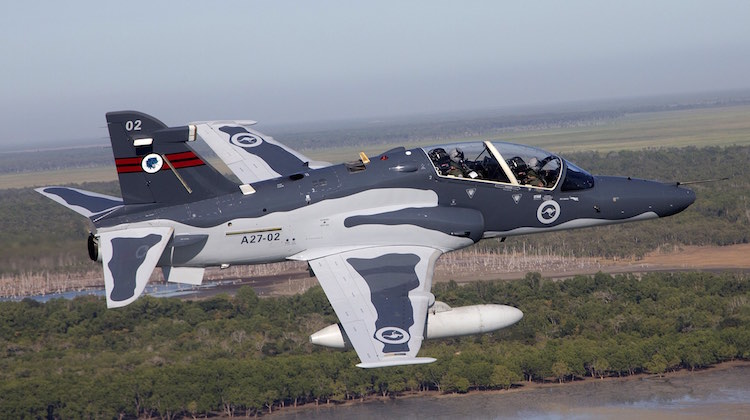 BAE Systems Australia has been selected to deliver operational maintenance for the Royal Australian Air Force (RAAF) Hawk 127 lead-in fighter fleet, increasing the scope of the company’s current in-service support contract.
BAE Systems Australia has been selected to deliver operational maintenance for the Royal Australian Air Force (RAAF) Hawk 127 lead-in fighter fleet, increasing the scope of the company’s current in-service support contract.
From the beginning of July next year, 116 new employees will deliver all maintenance support for the Hawk on the flightline at RAAF Base Williamtown and RAAF Base Pearce. This support includes aircraft launch and recovery, on site management support and deployment operations. With this change to the existing contract, BAE Systems will be providing a total sustainment solution, managing both deeper and operational maintenance, the company stated. The new arrangements are set to be phased in from October.
“By building on the unified approach we have with the Department of Defence to deliver Hawk deeper maintenance, our operational maintenance solution enables a more holistic approach to Hawk support that maximises aircraft serviceability for less cost,” said BAE Systems Australia director for Aerospace Steve Drury.
In a separate statement, Minister for Defence Kevin Andrews said the change will enable the RAAF to redirect personnel in support of other priorities, including the F-35.















Daryl
says:What is the expected life span of these little jets,they seem to have been around for a long time now.I remember the CO of the hawk operation at Williamstown telling us at the Temora Aviation museum,that he would love to bring some of the jets down for a flyin day,but they were just so over worked,he couldn’t afford the time off training.Maybe we didn’t buy enough way back when.
Heres your chance Corey …:-))
MikeofPerth
says:Questions for those in the know. I understand that the RAAF Hawks can be called into wartime use in an emergency through the carriage of Sidewinder missiles, bombs and gun pod.
If this was the case under what circumstances and how what they be used? My guess is that in the air to ground role they would mostly be confined to CAS and in the air to air role would be used for short range point intercept. Under these scenarios would they fly together and under the direction of front line fast jets only?
One scenario that also comes to mind is MH370. What if that flight had turned in the other direction and headed towards Perth? With no nearby front line combat aircraft able to be called upon on short notice, would the crews at RAAF Pearce be able to quickly prep a Hawk with Sidewinders and scramble to intercept?
Corey
says:Daryl just for being a smart ass I’ll point out that 33 BAE 127 back in June 1997 and where in Squadron No.76 and No.79 form 2000. The current BAE 127 Hawks are also in the stage of being converted to a Hawk 128 (Hawk T2) which began in 2014 and will be complete around 2017 form the info I can find. So I’d guess that it would give an expected life span to about 2025-2030 (10-15 years additional service) as no airline or RAAF would spend missions upgrading a whole fleet of aircraft costing millions. From a business point of view it makes sense to have the one company doing all the maintenance and upgrades on aircraft they built.
BH
says:@ Daryl..
I think their life of type is on track with what you’d expect of such a system. As to whether they’re being overworked that could be answered several ways.
From memory, and correct me if I’m wrong, the LIFT project was one of the first where Defence went to Industry and requested tenders where the the providers were to specify how many aircraft they believed the RAAF would require in order to meet a certain amount of training hours per year. BAE came back and said 33 airframes and thus that’s what we got. That was probably worked out to get the maximum no of hours out of a minimum number of airframes. So that explains why they have such little spare time or capacity available. You could call it a very efficient system, however you probably get very little extra capability.
If you look at the new Helicopter Training contract under Air 9000, I think there will be 15 new airframes to replace the kiowa and squirrels in the training role. However apart from training, those aircraft were also used for other ad hoc roles as well. Since the contract was awarded I’ve seen others ask what will fill that ad hoc light utility role if the 15 new eurocopters will be fully utilised by the training program…?
I think overall these programs create efficiency but limit operational flexibility and freedom.
So yes maybe we did need a few more airframes…
TimC69
says:I think we need to review our training,ground support and COIN needs, firstly may i suggest the Alenia M346 Master and Plilatus PC21-which i know has been chosen- be used in the role/s…45 of each split between 4 squardrons-approx the same numbers as currently used is the traing role.. we need to get more out of our aircraft and multi-role is what we should be asking from every platform in the ADF.
Jason
says:Why would we get the M346 when we already have the Hawk? I don’t understand your logic. Although we have 33 Hawks, only 24 or so are in service at any one time. The Hawks are also being upgraded to the Mk128 standard.
The PC-21 has already been selected, but contract negotiations appear to be dragging on and on.
What requirement do you see a COIN aircraft meeting?